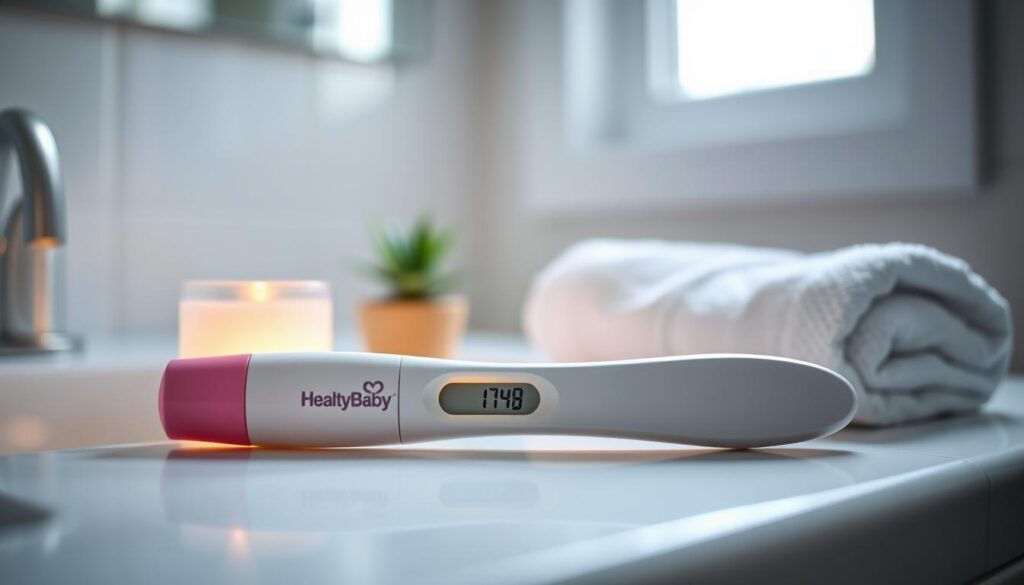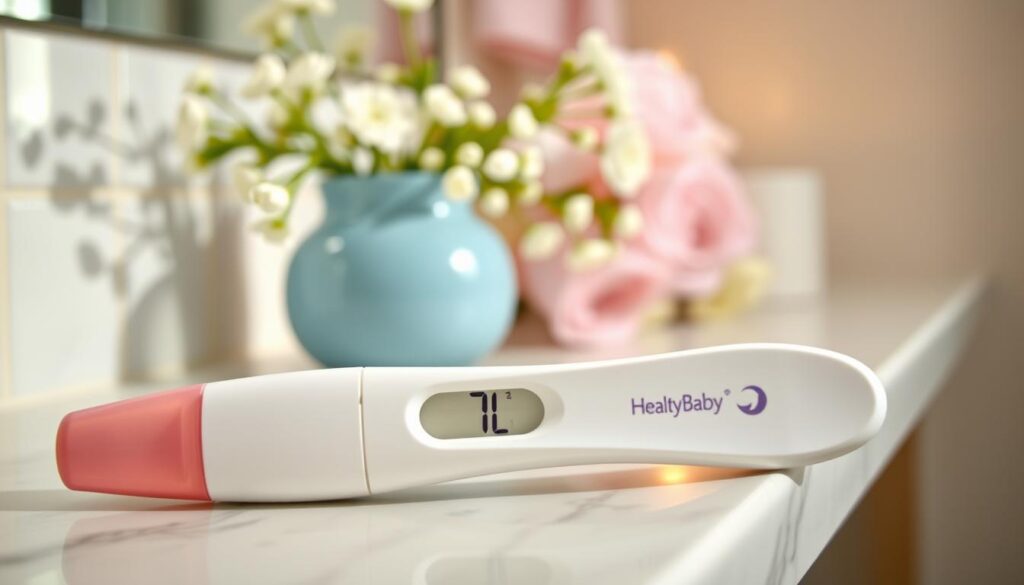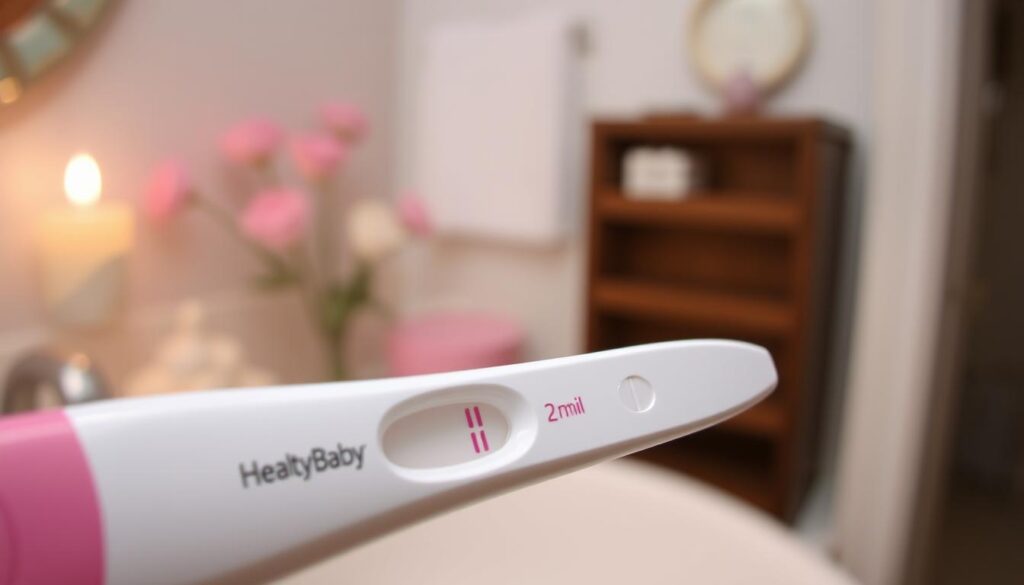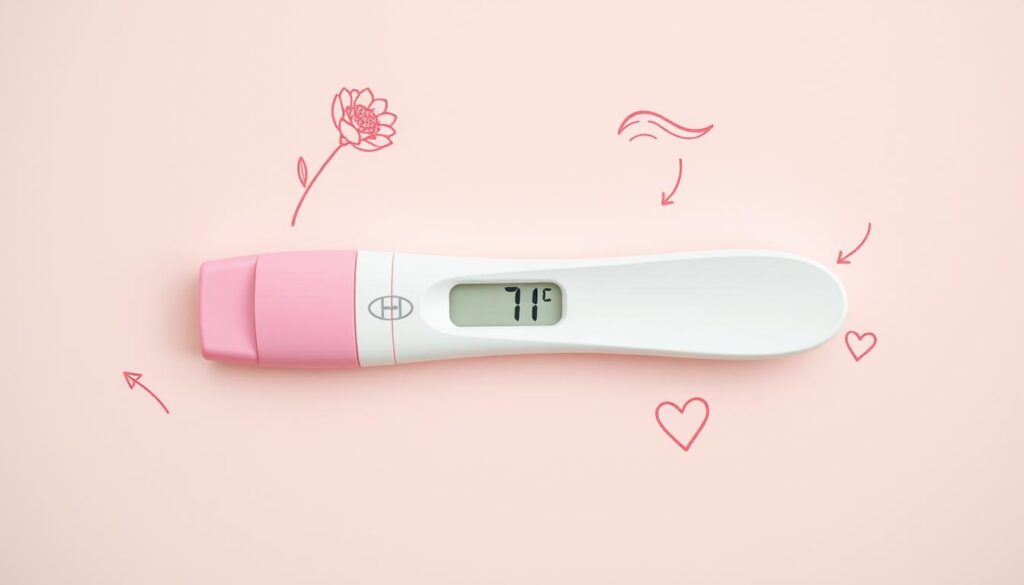Waiting to see those two pink lines can be both thrilling and a bit scary. You might look online for examples of positive pregnancy test pictures. This is because you want to know what your test might show. Even though positive tests look different, knowing what to look for can help a lot during this exciting time.
If you’re trying to get pregnant or just want to be ready, learning about positive pregnancy test pictures is helpful. You’ll see everything from the classic double line to more subtle digital results. These signs can give you peace of mind and help guide you as you move forward in your pregnancy.
Table of Contents
Understanding Pregnancy Test Results
Pregnancy tests look for the human chorionic gonadotropin (hCG) hormone. This hormone is made when a fertilized egg attaches to the uterine lining. Tests show results in different ways, like lines, signs, or digital displays.
Different Types of Result Lines
Non-digital tests show results as plus signs, faint lines, or color changes. It’s key to follow the instructions and read the results on time. This avoids mistakes and evaporation lines that can show up later.
Reading Test Windows Correctly
Pregnancy test windows have control indicators to show they’re working. To get the right results, look at these indicators. They help make sure the test is accurate.
Interpreting Digital Test Displays
Digital tests show clear “pregnant” or “not pregnant” results. They might cost more but are easier to understand. Yet, always follow the instructions for the best results.
| Test Type | Result Display | Accuracy | Cost |
|---|---|---|---|
| Non-Digital | Lines, signs, color changes | 99% accurate | Lower |
| Digital | “Pregnant” or “Not Pregnant” | 99% accurate | Higher |
It’s vital to follow the instructions and read the results on time. This ensures you get the right answer and avoid mistakes.
When to Take a Pregnancy Test for Best Results
For the most accurate early pregnancy detection, wait until the first day of your missed period to take a test. Some tests say they can find pregnancy 5-6 days before a missed period. But waiting ensures higher levels of human chorionic gonadotropin (hCG), the hormone tests look for. Taking a pregnancy test too early may result in a false negative.
If your menstrual cycles are irregular, wait at least three weeks after unprotected sex. This gives hCG levels time to rise to a detectable level. Also, testing with your first-morning urine is best, as it has the highest hCG concentration.
- For the most accurate results, wait until the first day of your missed period.
- Some tests claim to detect pregnancy 5-6 days before a missed period, but waiting ensures higher hCG levels.
- For irregular cycles, wait at least 3 weeks after unprotected sex before testing.
- Test with first-morning urine, as it has the highest hCG concentration.
“Pregnancy tests are 99% accurate when used properly.”
By following these tips, you’ll get the most reliable early pregnancy detection results when taking a best time for pregnancy test.

Positive Pregnancy Test Pictures and What They Mean
Positive pregnancy test results can show different things. The lines or digital display can tell you a lot. Knowing what these signs mean helps you understand your test and how far along you are.
Clear Positive Results
A clear positive test shows bold lines or a “+” sign. This means you’re definitely pregnant. It shows the pregnancy hormone, hCG, is there.
Faint Line Examples
Faint lines also mean you might be pregnant. Even the smallest line is a positive sign. The strength of the line doesn’t always show how far along you are. hCG levels can vary.
Digital Test Display Examples
Digital tests show “Pregnant” or a similar message. They’re clear and easy to read. These tests give you a sure answer about your pregnancy.
Any line, no matter how faint, means you might be pregnant. Getting the same result on different tests makes you more sure.

How Home Pregnancy Tests Work
Home pregnancy tests look for the human chorionic gonadotropin (hCG) hormone in your urine. This hormone comes from cells in the placenta. It helps the fertilized egg grow in the uterus.
The tests use antibodies to find hCG in your urine. This reaction shows if you’re pregnant. The test’s sensitivity is measured in mIU/mL. A lower number means it can find hCG sooner.
hCG levels grow fast in early pregnancy, doubling every 48-72 hours. This is why some tests can find pregnancy sooner. Digital tests, for example, give quick and accurate results.

- Your urine sample goes on the test strip.
- The hCG in your urine meets the antibodies on the strip.
- The antibodies have a colored dye that shows up on the test.
- The test quickly checks the hCG levels and shows the result.
Knowing how these tests work helps you understand your results. This can guide your healthcare choices.
Common Signs That Accompany a Positive Test
Discovering you’re pregnant is exciting and life-changing. A positive test is the first sign, but you’ll notice many physical and emotional changes early on. Knowing these signs can reassure you and guide your next steps.
Physical Symptoms
Some early pregnancy symptoms include:
- Sore or tender breasts
- Fatigue and increased tiredness
- Nausea, often referred to as “morning sickness”
- Bloating and changes in appetite
- Frequent urination
- Implantation bleeding or cramping
These signs can start a few days after conception and get stronger in the first trimester. For instance, about two-thirds of pregnant people experience nausea or vomiting early on. Morning sickness usually starts around week 8 and gets better after 12 weeks.
Emotional Changes
You might also feel emotional changes early in pregnancy. Mood swings, anxiety, and excitement are common as you get used to this new life stage. Increased sensitivity to stress and emotional triggers can cause mood swings due to hormonal changes.
When to Contact Your Healthcare Provider
After a positive test, contact your healthcare provider right away. They can confirm the pregnancy, talk about your options, and help plan your prenatal care. Getting early and regular prenatal care is key for a healthy pregnancy and baby.

Factors Affecting Test Accuracy
Pregnancy tests need to be accurate. But, different things can make the results not true. Knowing these can help you understand your test better and what to do next.
The timing of when you take the test is key. Taking it too soon can give a false negative. This is because there’s not enough hCG hormone in your urine yet. For the most accurate results, wait until after your missed period.
How concentrated your urine is also matters. If your urine is too diluted, like from drinking too much water, it can show a false negative. Use your first-morning urine for the best results, as it typically contains the highest levels of hCG.
- Improper storage or sunlight can ruin the test and give false results.
- Some medicines, like fertility drugs with hCG, can cause false positives.
- Not following the instructions can also mess up the test’s accuracy.
Even though pregnancy tests are usually right, knowing what can go wrong is important. If you’re unsure about your results, talk to a healthcare provider. They can give you a clear answer and help you.
“Pregnancy tests are approximately 99% accurate when used correctly, but false results can occur for various reasons.”
Different Types of Pregnancy Tests Available
There are many home pregnancy tests out there. From simple line tests to digital displays, knowing your options helps you pick the right one. Let’s look at the main types: traditional line tests, digital tests, and testing strips.
Traditional Line Tests
Traditional line tests are the most common and affordable. They show pregnancy with colored lines. Seeing two lines means you’re likely pregnant.
Digital Tests
Digital tests show “Pregnant” or “Not Pregnant” on a screen. They might cost more, but are easier to read than line tests.
Testing Strips
Testing strips are a cheaper choice. You dip them in urine to see if you’re pregnant. They work like traditional line tests.
All these tests look for hCG in your urine. Some can find hCG sooner than others. This means you might get a result earlier with some tests.
Think about cost, ease of use, and what you prefer when picking a test. The types of pregnancy tests and home pregnancy test options let you find the perfect one for you.
False Positives and False Negatives Explained
Dealing with pregnancy test results can be tricky. It’s important to know about false positives and false negatives. False negatives, where the test misses a pregnancy, happen more often. This usually happens if you test too early or use the test wrong.
False positives, where the test says you’re pregnant when you’re not, can also occur. Reasons include expired test kits, recent miscarriage or abortion, and certain medical conditions. Even fertility meds with human chorionic gonadotropin (hCG) can cause false positives.
If a test shows you’re pregnant but you don’t feel like it, take another test and talk to your doctor. They can do a blood test, which is very accurate for checking pregnancy. Waiting a few days and testing again can also help clear things up.
While false positives and negatives can be upsetting, they don’t happen often. Knowing why they happen and what to do can help you feel more confident. This way, you can get the right care and support for your situation.
“Understanding the nuances of pregnancy test accuracy is key for making smart choices about your health and family planning.”
Best Practices for Taking a Pregnancy Test
To get the most accurate results, follow these steps when taking a home pregnancy test. First, use your first morning urine. It has the highest levels of human chorionic gonadotropin (hCG), the hormone the test looks for. Also, make sure to check the test kit’s expiration date and follow the instructions carefully.
Don’t drink too much water before the test. Too much water can make your urine too diluted, leading to a false negative. For the best results, wait until at least the first day of your missed period. If you’re not sure, take more tests or talk to your healthcare provider.
If the test shows you’re pregnant, start taking prenatal vitamins right away. Make any needed changes in your lifestyle to support a healthy pregnancy. Remember, home pregnancy tests are very accurate when used right. Trust the results and take the next steps.
FAQ
What do positive pregnancy test pictures look like?
How do I read and interpret the different types of pregnancy test results?
When is the best time to take a pregnancy test for optimal accuracy?
What do positive pregnancy test pictures with faint lines mean?
How do home pregnancy tests work?
What are some common signs and symptoms that accompany a positive pregnancy test?
What factors can affect the accuracy of a pregnancy test?
What are the different types of pregnancy tests available?
What is the difference between a false positive and a false negative pregnancy test result?
What are the best practices for taking a pregnancy test?
Source Links
- Positive Pregnancy Test – ZoeCare – Yankton, South Dakota Pregnancy Test Ultrasound Exam
- Pregnancy Tests
- Here’s What To Do for the Most Accurate Pregnancy Test Results at Home
- Pregnancy Test Checker
- How Soon After Ovulation Can You Test For Pregnancy? | Kin Fertility
- *This* Is The Best Time Of Day To Take A Pregnancy Test For Accurate Results
- Pregnancy Test Progression: What Should It Look Like?
- What is Chemical Pregnancy?
- What Does a Positive Ovulation Test Look Like? See Examples
- 13 Simple Homemade (DIY) Pregnancy Tests: Do They Work?
- Will an Ovulation Test Be Positive If You’re Pregnant? | Kin Fertility
- Period or Pregnancy? How to Tell If Sore Breasts Means You’re Expecting | Kin Fertility
- 20 Early Signs Of Pregnancy After Missed Period
- 12 Reasons For False Positive Home Pregnancy Tests
- Pregnancy Symptoms, First Signs, and FAQs | Pregnancy Testing, Ultrasound info | Network Medical
- Ultrasound Before an Abortion: Why it Matters | Pregnancy Resource Center | Mountain Grove, MO
- Holistic Analysis and Development of a Pregnancy Risk Detection Framework: Unveiling Predictive Insights Beyond Random Forest – SN Computer Science
- How to Avoid False Positives and False Negatives when Diagnosing Adult ADHD?
- What Types of Contraception Are Best Following Early Pregnancy Loss? – Pediatrics Nationwide
- About Congenital Syphilis
